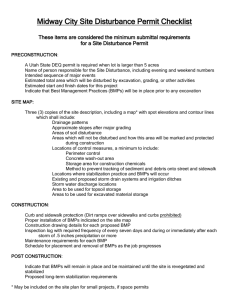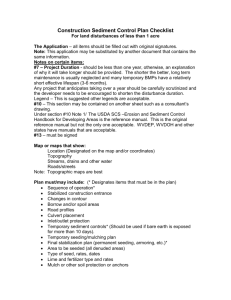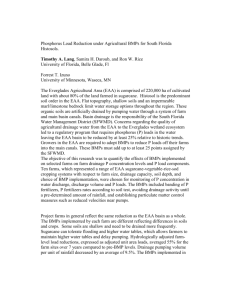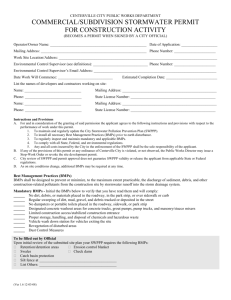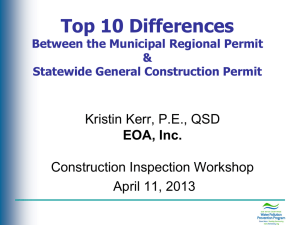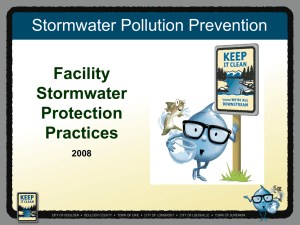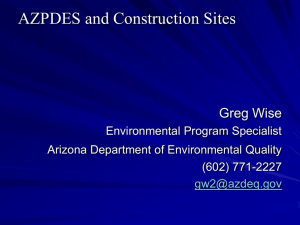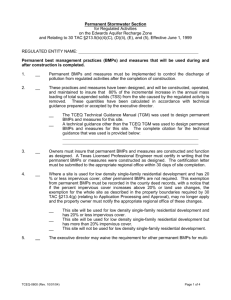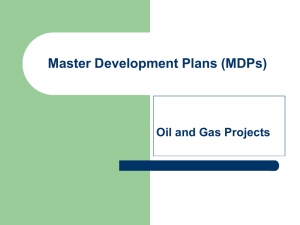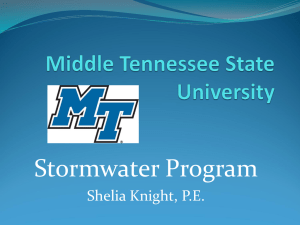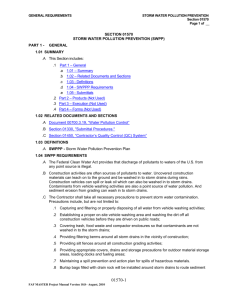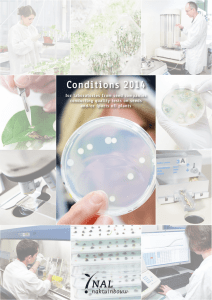The 2014 Industrial Storm Water NPDES Permit - (AWMA)
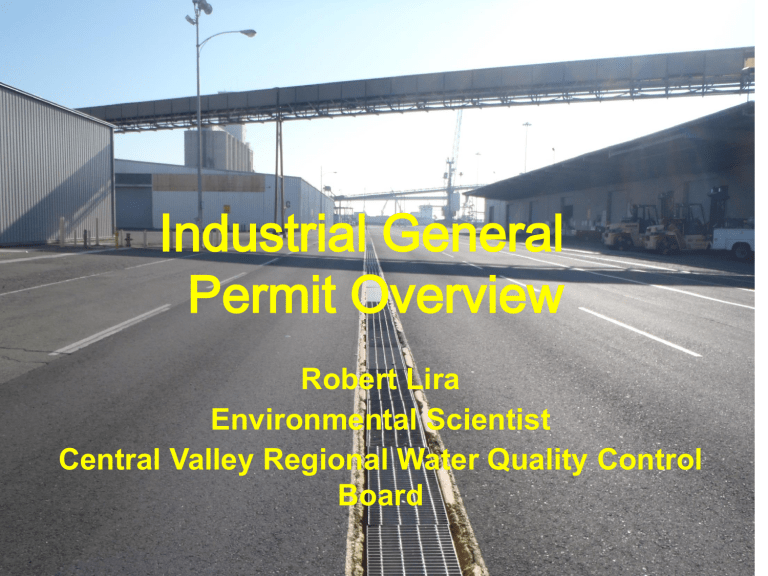
Industrial General
Permit Overview
Robert Lira
Environmental Scientist
Central Valley Regional Water Quality Control
Board
Goals
Performance Based Model
Improved Data Quality
Incentives and Flexibility
Industrial Permit Timeline
1991 – State Water Board adopts Industrial General Permit
(92-12)
1997 - State Water Board adopts Industrial General Permit
(97-03-DWQ – “current permit”)
2003-2005 – Prior draft IGPs, Blue Ribbon Panel of Experts address the feasibility of Numeric Effluent Limits, development of SMARTS electronic information system.
2011-2013 – State Water Board hearings on previous drafts of the permits
April 1, 2014 – State Water Board considers adoption of the
Industrial General Permit.
Effective Date July 1, 2015
Section II Receiving General Permit Coverage
Notice of Intent Coverage – July 1, 2015
No Exposure Certification Coverage – October 1, 2015
Permit Registration Documents required
Notice of Termination
All reporting electronically certified and submitted by
Discharger
Electronic Reporting Requirements
Dischargers are required to submit and certify all documents electronically via the Storm Water Multiple Application and
Report Tracking System (SMARTS)
Permit Registration Documents, Sampling and Analysis
Data, Annual Report Checklist, Reports
Public Transparency
Efficiency
Analysis of industrial program
Storm Water Pollution
Prevention Plan (SWPPP)
Requirements
Minimum Best Management
Practices (BMPs)
Section X.H
Implementation of the minimum BMPs (mostly nonstructural) to the extent feasible required
Represents common practices at industrial facilities
Basis for compliance with technology-based effluent limitations and water quality based receiving water limitations.
Advanced BMPs
Section X.H.2
Mostly structural and exceed the performance expectation of minimum BMPs
Required to meet design storm standards
Consists of: treatment control BMPs, exposure reduction BMPs, and storm water containment and discharge reduction BMPs
Utilize advanced BMPs that infiltrate or reuse storm water (where feasible)
Design Storm Standards for
Treatment Control BMPs
Section X.H.6
85 th percentile 24-hour storm standard for both volume- and flow-based criteria.
LA SUSMP requirement and CASQA BMP Manual
Requires local historical rainfall records
Dischargers are not required to retrofit existing treatment control BMPs until possibly in Level 2
Other SWPPP Changes
• Temporary Suspension of
Industrial Activities
Monitoring Implementation
Plan
Monitoring
Requirements
ents
Sampling Protocols
Section XI.B
Two QSEs from July 1 to December 31 st and two QSEs from January 1 to June 30 of the
Reporting Year
During scheduled facility operating hours
From each drainage location within four hours or the start of scheduled facility operating hours if the QSE occurred in the previous twelve (12) hours.
Qualifying Storm Event (QSE)
Section XI.B.1
Precipitation event that:
Produces a discharge for at least one drainage area;
Is preceded by 48 hours with no discharge from any drainage area
Results in an increase number of QSEs eligible for sample collection
Other Monitoring Requirements
pH screening
Alternative Discharge Locations
Representative Sampling Reduction
Qualified Combined Samples
Sample Frequency Reduction
Section XII Exceedance
Response Actions (ERA)
Process
Numeric Action Levels (NALs)
Annual NAL exceedance
The average of all the analytical results for a parameter from samples taken within a reporting year exceeds an annual NAL value for that parameter listed in Table 5 (or is outside the NAL pH range)
Instantaneous maximum NAL exceedance
Two or more analytical results for TSS, O&G, or pH from samples taken within a reporting year exceed the instantaneous maximum NAL value (or is outside the NAL pH range).
Baseline Status
Numeric Action Levels
Minimum BMPs/possibly Advanced BMPs
Inspection, Implementation, Maintenance
Visual Monitoring
Sample 4 qualified storm events per reporting year
NAL Exceedances
Trigger
Annual Average exceeds the annual NAL values
(within a reporting year)
Any two or more samples for a single parameter exceed the NAL values in a reporting year (TSS, O&G, or pH )
EXCEEDANCE RESPONSE ACTIONS (ERAs)
Baseline Status
(all facilities start here)
Sampling NALs
Trigger
Sampling
Level 1 Status
Trigger
NALs
Level 2 Status
Sampling
NALs
Trigger
Industrial Activity BMP
Demonstrations with NO Future
NAL Exceedances Return to
Baseline Status
Level 1 ERA Timeline
Status changes - July 1
Evaluation by October 1 Prior to implementation of
BMPs or October 1, sampling not included in calculations for Level 2
Level 1 Report (QISP, Evaluation, Summary Site/BMP changes in SWPPP) by January 1
Level 2 ERA Timeline
Status changes next July 1
Action Plan: QISP, facility plan for addressing exceedances, and a schedule - January 1
Technical Report : QISP, Evaluation,
Treatment/Structural BMPs implemented - January 1 of the next reporting year
Implementation Extension: Regional Board approval required if over 6 months requested and submitted electronically
Training Qualifications
Section IX
Dischargers shall appoint QISP – internal or external
No prerequisites
Training is not “intro to storm water”
Only Dischargers with Level 1 and Level 2 status
ERA reporting and Action Plan, New Dischargers with 303(d) impaired receiving waters
Training Qualifications
Section IX
California licensed professional civil, industrial, chemical, and mechanical engineers and geologists
Parallel and streamlined training process to be a QISP
Inactive Mining Storm Water Pollution Prevention Plans
(SWPPPs) , NONA Technical Reports, and Subchapter N calculations
Compliance Groups
Section XIV
Substantially similar industrial activities
50% sampling reduction
Compliance Group Leaders - approved through the State Water Board approved training program
Inspect annually
Prepare Level 1 and Level 2 ERA reports
Executive Director may review the Groups
Conditional Exclusion – No
Exposure Certification (NEC)
Section XVII
Checklist - 11 categories of no exposure for industrial materials/activities
No SWPPP or monitoring required
Annual fee (low), inspection and recertification
Regional Boards can deny if invalid
Plastic Materials
Section XVIII
AB 258 required control of preproduction plastics
Ineligible for coverage unless criteria met virgin and recycled “preproduction” materials
Requires containment (1 mm mesh meet peak flow rate from 1-yr 1-hour storm)
If containment infeasible, alternative containment BMPs can be proposed
Exemption from containment criteria (NEC, 8 BMPs)
